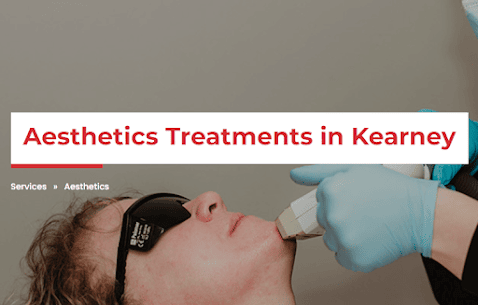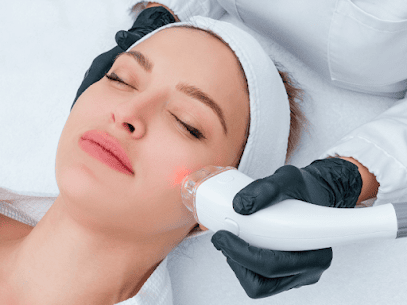Stretch marks are a common concern for many individuals, affecting both men and women. These unsightly marks often result from rapid growth, pregnancy, weight changes, or genetics. While they are a natural part of life, many people seek ways to reduce their appearance, and one effective method gaining popularity is laser therapy. In this comprehensive guide, we’ll delve into the world of laser therapy for stretch marks, discussing its efficacy, safety, and the procedure itself.

What Are Stretch Marks?
Before we explore laser therapy as a solution, it’s crucial to understand the nature of stretch marks. These are narrow streaks or lines that develop on the skin when it undergoes rapid stretching. Common causes include pregnancy, rapid weight gain or loss, puberty, and muscle-building exercises. Stretch marks are often found on the abdomen, thighs, hips, breasts, and buttocks.
While they don’t pose a health risk, stretch marks can impact an individual’s self-esteem. Many seek ways to reduce their appearance, and laser therapy has emerged as a promising option.
Types of Stretch Mark Treatments
Before we dive into the specifics of laser therapy, it’s essential to note that various treatment options are available for stretch marks. These include topical creams, microdermabrasion, chemical peels, and microneedling. The choice of treatment should align with individual needs and preferences.
However, laser therapy stands out for its efficacy in reducing the appearance of stretch marks, making it a popular choice for those seeking a non-invasive and efficient solution.
The Science Behind Laser Therapy
Laser therapy, or laser light therapy, is a method that uses focused laser beams to treat various skin conditions, including stretch marks. It works by stimulating the production of collagen and elastin in the skin, which are essential for maintaining skin elasticity and structure.
The laser energy is absorbed by the skin, creating controlled micro-injuries that prompt the skin’s natural healing response. This, in turn, leads to the production of new collagen and elastin fibers. As a result, the treated area becomes firmer, smoother, and the appearance of stretch marks is visibly reduced.
Efficacy and Clinical Evidence
When considering any medical or cosmetic treatment, it’s essential to examine the evidence supporting its efficacy. Laser therapy for stretch marks has a growing body of scientific support.
In clinical studies, it has been observed that 87% of patients experienced a significant reduction in the appearance of their stretch marks at six months after their final laser session, compared to 80% at three months. This demonstrates that the results of laser therapy can continue to improve with time, with noticeable changes appearing as early as one month after the third treatment session.
These findings highlight the potential of laser therapy as a promising option for those looking to reduce the visibility of their stretch marks.
Safety and Side Effects
As with any medical or cosmetic procedure, it’s crucial to consider the safety and potential side effects of laser therapy for stretch marks. While laser therapy is generally safe, there are some side effects to be aware of, which may include redness, swelling, and temporary discomfort at the treatment site. It’s important to consult with a qualified healthcare professional before undergoing the procedure to ensure it is suitable for your specific needs and skin type.
Reputable providers prioritize safety and will take all necessary precautions to minimize any potential risks. It’s also important to follow post-treatment care instructions diligently to support healing and recovery.
Preparing for Laser Therapy
Before embarking on laser therapy for stretch marks, it’s essential to prepare adequately. Consultation with a qualified healthcare professional or dermatologist is the first step. During the consultation, your provider will assess your specific needs, explain the procedure, and discuss potential outcomes.
In preparation for laser therapy, you may be advised to avoid sun exposure and self-tanning products, which can increase the risk of skin sensitivity and complications. Your provider will provide detailed pre-treatment instructions to ensure optimal results.
The Laser Therapy Procedure
Now, let’s explore what the actual laser therapy procedure for stretch marks entails. The treatment typically involves the following steps:
- Cleansing: The treatment area is thoroughly cleaned to remove any oils, lotions, or cosmetics.
- Anesthesia: Some individuals may receive a topical numbing cream to minimize discomfort during the procedure.
- Laser Application: The healthcare professional uses a specialized laser device to deliver focused laser beams to the targeted stretch mark areas.
- Post-Treatment Care: After the procedure, your provider will give you specific instructions for aftercare, which may include applying soothing creams and avoiding direct sun exposure.
The duration of a session can vary depending on the size and number of stretch marks being treated. Most sessions are relatively quick, allowing individuals to return to their daily activities afterward.

Aftercare and Recovery
Post-treatment care and recovery are critical aspects of the laser therapy process. To ensure the best results, it’s essential to follow your provider’s instructions diligently. This may include:
- Gentle Skincare: Use mild, non-irritating skincare products recommended by your provider to support healing and minimize discomfort.
- Avoid Sun Exposure: Protect the treated areas from direct sunlight to prevent hyperpigmentation.
- Stay Hydrated: Drinking plenty of water helps maintain skin health and supports the body’s natural healing processes.
In most cases, individuals experience minimal downtime and can resume their normal activities shortly after a session. However, it’s essential to prioritize your skin’s health and well-being during the recovery period.
Finding a Qualified Provider
To ensure a safe and effective experience with laser therapy for stretch marks, it’s crucial to find a reputable and qualified provider. Here are some tips for locating the right professional:
- Research: Read reviews and seek recommendations from trusted sources to identify providers with a proven track record.
- Consultation: Schedule a consultation with the provider to discuss your goals, concerns, and to assess their qualifications and experience.
- Ask Questions: During the consultation, don’t hesitate to ask questions about the procedure, potential risks, and expected outcomes.
- Certifications: Verify the provider’s certifications, ensuring they are licensed and experienced in performing laser therapy for stretch marks.
Selecting the right provider is a crucial step toward achieving the best results and a positive treatment experience.
Real-Life Experiences
One of the most compelling aspects of considering laser therapy for stretch marks is hearing real-life experiences from individuals who have undergone the procedure. Testimonials and patient stories can provide valuable insights into what to expect.
Many individuals have reported significant improvements in the appearance of their stretch marks after laser therapy. Some have shared before-and-after photos, highlighting the noticeable changes in skin texture and tone.
These personal accounts can be encouraging for those considering laser therapy, demonstrating the potential for positive outcomes.
Conclusion
In conclusion, laser therapy for stretch marks is an effective and non-invasive option for individuals looking to reduce the appearance of these common skin blemishes. Backed by clinical evidence and personal testimonials, this treatment can offer hope to those seeking a solution to stretch marks.
Remember that safety and the expertise of the provider are paramount when considering laser therapy. Consult with a qualified healthcare professional or dermatologist to determine if this treatment is suitable for your individual needs.
The journey to smoother, more radiant skin starts with informed decisions and professional guidance. Consider laser therapy as a viable option in your quest for flawless skin.

